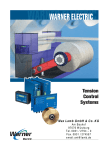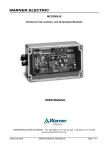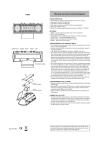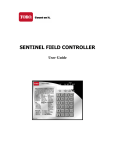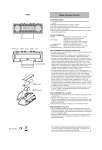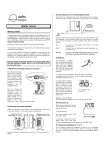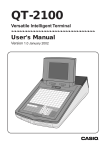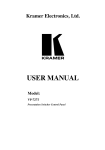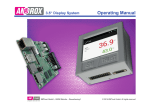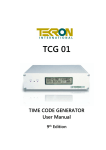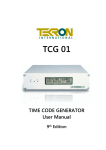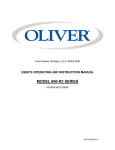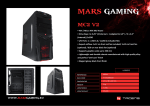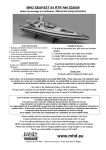Download Automatic setting by dancer arm
Transcript
I - Simple tension control in closed loop If your machine requires a very accurate web tension control, then you need to work in closed loop. An important unit in the loop is the sensor. Several possibilities are offered. The choice now depends on the kind of machine you are building, the mechanical construction and the max tension value you desire to control. MAIN APPLICATIONS - ADVANTAGE – DISADVANTAGE Setting type Dancer arm Where, When, Why ? ❐ Printing machines ❐ Intermittent function ❐ Flying splice need Advantage ❐ Absorb tension peak ❐ Can act as store ❐ Easy flying splice ❐ Accel / decel machine phase well absorbed ❐ Flexibility Disadvantage ❐ Need more space ❐ Moving parts Sensor MCS605-E 110/230 VAC Dancer arm Analogue Control MCS202-E Brake TB 28 31 Brake MPB 34 41 0 - 24 VDC Additional functions ❐ ❐ ❐ ❐ 14 Brake open Emergency stop Drift stop(stop integral term of PID) Gain change Automatic setting by dancer arm ROTARY SENSOR MCS605-E (see pages 16 and 17) ANALOGUE CONTROL MCS202-E ❐ MCS202-E1 Standard execution ❐ MCS202-E54 Standard IP54 protected ❐ MCS202-EC1 Open frame execution Technical characteristics – valid for 3 executions Range - Values 110-220 VAC selectable Max 2, 5 Amps, short circuit protected Loop gain Offset torque 0-24 VDC Metal rugged housing 2 adjustable range selection MCS-KIT1, 2, 3, 5 and 6 Dancer arm with MCS605-E MC403 Power supply Output current capability User settings Output voltage brakes Housing Loop gain Accessories Sensor compatible Service manual Comments Open front face to access Able to power 2 TB in parallel Front face potentiometer Front face potentiometer Compatible all elec. Warner Electric Only MCS202-E1 and –E54 Can be change during operation See details on page 17 See details on pages 16 and 17 Technical information MCS202 control is based on classical and fixed PID terms. The loop gain can be set on front face potentiometer. Due to the fixed PID terms, its use is limited in terms of roll diameter ratio. One input is provided to change the loop gain and has to be used when diameter ratio exceeds 8. To ensure proper operation it is important to wire the function “Drift Stop”. This function releases the Integral term as soon as the machine runs. 99 37 29 Dimensions (mm) 51,5 73 60 87 282 265 MCS 202-E LOOP GAIN 14,3 BRAKE TORQUE OFFSET ø65 57 120 POWER 15 Automatic setting by dancer arm ROTARY SENSOR MCS605-E A position sensor is used in 2 possible ways: ❒ - To detect dancer moving in the closed loop installation working on dancer principle. ❒ To sense the diameter of the roll to operate open loop control or make PID compensation in closed loop installation. Power supply Max. detection angle Sensitivity Service manual MCS605-E 10 to 30 VDC / 30 mA (or ± 5 to 15 VDC) 200° or ± 100° 2,5 mV / V / ° MC483 ELECTRICAL CONNECTIONS CONNECTOR CABLE – Supply White 3 +15 V 2 Green Signal 4 + Supply Brown -15 V 1 Shield Signal View from outside Sensor Working in closed loop with the arm dancer principle is very popular especially in the printing market where a good flexibility of the system is required to absorb the eventual “tension peaks”. The rotary sensor is necessary to read the dancing roll movement. MCS605-E is ideal for easy mounting. It is encapsulated in rugged metal housing preventing mechanical shocks. Furthermore it is provided with built in switch in order to change the signal output polarity. TB brake 16 Automatic setting by dancer arm MCS605-E ACCESSORIES The MCS202-Exx is designed to work with dancer arm principle. Usually the sensor is a rotary type. Warner Electric sensor MCS605-E are delivered with complete mounting kit. Mounting kit comprises of CABLE, COUPLING, BRAKETS and all necessary SCREWS. Various KITS have various lengths of cable and cable with or without connector at control end side. MCS2000 line requires free leads (MCS2000 control line is provided with terminal block). MCS202-Exx requires a connector (MCS202-Exx is provided with the connector). Cable length 3m 3m 4,5 m 4,5 m 6m 8m MCS-KIT1 MCS-KIT2 MCS-KIT3 MCS-KIT4 MCS-KIT7 MCS-KIT8 One / Two connectors 2 1 2 1 2 1 Compatible MCS202-Exx MCS2000 MCS202-Exx MCS2000 MCS202-Exx MCS2000 Dimensions (mm) – Mounting 130 50,8 min 47 / max 70 18 57 ø6,35 65 Coupling 3x1 20° 57 31,6 ø38,1 45 14,2 38,1 21,9 ø6,5 3 x ø45 17 II - Double tension control in closed loop (modular) MCS2000-ECA is a digital controller that can be used in both open or closed loop. Operation in open and closed loop is also possible. It is mainly destined for OEM application. The programming tool is detachable. Sensor, sensor mounting kit, display are available as options. The unit has to be powered with 24 VDC. MAIN APPLICATIONS - ADVANTAGE – DISADVANTAGE Setting type Dancer arm Where, When, Why ? ❐ Printing machines ❐ Intermittent function ❐ Flying splice need Advantage ❐ Absorb tension peak ❐ Can act as store ❐ Easy flying splice ❐ Accel / decel machine phase well absorbed ❐ Flexibility Disadvantage ❐ Need more space ❐ Moving parts Sensor MCS605-E 16 17 Dancer arm Brake TB Memory card MCS2000-CRD-2 28 31 Amplifier MCS2000-PSDRV Brake MPB 11 34 41 Controller MCS2000-ECA 100 - 260 VAC 0 - 10 VDC or Hand Programmer MCS2000-PRG Amplifier MCS2000-DRV 24 VDC 18 11 MCS2000-WIN programme Automatic setting by dancer arm ELECTRICAL AMPLIFIERS MCS2000-PSDRV and MCS2000-DRV (see page 9) ROTARY SENSOR MCS605-E (see pages 16 et 17) CONTROLLER MCS2000-ECA ❐ Digital controller - 2 channels Main Characteristics ❐ ❐ ❐ ❐ ❐ ❐ ❐ ❐ ❐ ❐ ❐ ❐ 24 VDC power supply unit PID parameters setting on line Automatic adaptation for PID parameters, splicing logic included Opto isolation for input and output Compatible PLC Automatic sensor scaling and output sensor information Programming easy by pocket keyboard or PC(Windows) Available in open loop as calculator 2 analogic input, 2 output channels Plugable memory card Three language available Most dedicated for unwinding and rewinding with electromagnetic brakes and clutches. ❐ Service manual : MC514 MCS2000-PRG - HAND PROGRAMMER ❐ ❐ ❐ ❐ ❐ 4 command keys only 2 x 16 characters display Menu in 3 languages Connectable and disconnectable during operation Supply by control MCS 2000-EC MCS2000-CRD-2 - MEMORY CARD All setting data saved. It allows a quick loading operation on new machine or on running machine to optimise. ❐ Memory for 2 different programs ❐ Plugable on line in MCS2000-ECA unit MCS2000-WIN – PROGRAMME The program can modify the running setting by this software running with: Windows 95/98/XP/2000. 19 III - Double tension control in closed loop (compact) The command unit MCS2000-CTDA is a complete solution with power supply and programmer display integrated. There are 2 software version available. See technical data below MAIN APPLICATIONS - ADVANTAGE – DISADVANTAGE Setting type Dancer arm Where, When, Why ? ❐ Printing machines ❐ Intermittent function ❐ Flying splice need Advantage ❐ Absorb tension peak ❐ Can act as store ❐ Easy flying splice ❐ Accel / decel machine phase well absorbed ❐ Flexibility Disadvantage ❐ Need more space ❐ Moving parts Sensor MCS605-E 16 17 Dancer arm Brake TB Memory card MCS2000-CRD-2 28 31 Amplifier MCS2000-PSDRV Brake MPB 11 34 41 Controller MCS2000-CTDA 100 - 260 VAC 0 - 10 VDC or Amplifier MCS2000-DRV 24 VDC 20 11 MCS2000-WIN programme Automatic setting by dancer arm ELECTRICAL AMPLIFIERS MCS2000-PSDRV and MCS2000-DRV (see page 9) ROTARY SENSOR MCS605-E (see pages 16 et 17) CONTROLLER MCS2000-CTDA Specifications Input power supply 110-240 VAC selectable Analogue inputs Two analogue inputs 0-10 VDC Analogue outputs Two controlled channels Open loop signal ± 10 VDC, 0-20 mA 0-10 VDC Digital inputs Set point change + Set point change – Set point change ± active low active low front face switch Gain multiplier Output limitation ABC binary combination ABC inputs synchronisation Stop integral form active low active low active low active low active low Digital outputs Sensor level indication Two binary outputs Main features ❐ ❐ ❐ ❐ ❐ ❐ ❐ ❐ ❐ ❐ ❐ ❐ ❐ ❐ Three mounting possibilities Software password protected Scrolling menu program Multipurpose application RS232 communication Two ouput channels Automatic sensor scaling Programmable output configuration Output sensor information External set point change Automatic or imposed PID correction All features requested for tension control Plugable memory card Variable tension value to prevent telescopic effect on unwinding – CTDA-22 ❐ Service manual : MC525 Other outputs Power supply sensor Power supply Voltage reference ± 15 VDC / 100 mA ± 5 VDC / 100 mA 24 VDC + 10 VDC / 10 mA MCS2000-CRD-2 - MEMORY CARD All setting data saved. It allows a quick loading operation on new machine or on running machine to optimise. ❐ Memory for 2 different programs ❐ Plugable on line in MCS2000-ECA unit MCS2000-WIN – PROGRAMME The program can modify the running setting by this software running with: Windows 95/98/XP/2000. 21 IV - Double tension control in closed loop The command unit MCS2000-CTLC is a complete solution with power supply and programmer display integrated. There are 2 software version available. See technical data below MAIN APPLICATIONS - ADVANTAGE – DISADVANTAGE Setting type Load cell Where, When, Why ? ❐ Slitter, Sheeter Coater ❐ For heavy material ❐ Limited room ❐ No fast accel/decel ❐ Tension peak accepted Advantage ❐ Direct tension measure ❐ Mechanically well integrated ❐ No moving part Disadvantage ❐ No tension peak absorption ❐ Accel/decel machine not easy to manage ❐ Flying splice function not easy One or two load cells Memory card MCS2000-CRD-2 Amplifier MCS2000-PSDRV Brake TB 11 28 31 Controller MCS2000-CTLC Brake MPB 34 41 100 - 260 VAC 0 - 10 VDC or Amplifier MCS2000-DRV 0 - 24 VDC 11 0 - 24 VDC 24 VDC 22 MCS2000-WIN Programme Automatic setting by load cell ELECTRICAL AMPLIFIERS MCS2000-PSDRV and MCS2000-DRV (see page 9) CONTROLLER MCS-2000-CTLC Specifications Input power supply 110-240 VAC selectable Analogue inputs Two analogue inputs 0-10 VDC Analogue outputs Two controlled channels Open loop signal ± 10 VDC, 0-20 mA 0-10 VDC Digital inputs Set point change + Set point change – Set point change ± active low active low front face switch Gain multiplier Output limitation ABC binary combination ABC inputs synchronisation Stop integral form active low active low active low active low active low Digital outputs Sensor level indication Two binary outputs Main features ❐ ❐ ❐ ❐ ❐ ❐ ❐ ❐ ❐ ❐ ❐ ❐ ❐ ❐ Three mounting possibilities Software password protected Scrolling menu program Multipurpose application RS232 communication Two ouput channels Automatic sensor scaling Programmable output configuration Output sensor information External set point change Automatic or imposed PID correction All features requested for tension control Plugable memory card Service manual : MC525 Other outputs Power supply sensor Power supply Voltage reference ± 15 VDC / 100 mA ± 5 VDC / 100 mA 24 VDC + 10 VDC / 10 mA MCS2000-CRD-2 - MEMORY CARD All setting data saved. It allows a quick loading operation on new machine or on running machine to optimise. ❐ Memory for 2 different programs ❐ Plugable on line in MCS2000-ECA unit MCS2000-WIN – PROGRAMME The program can modify the running setting by this software running with: Windows 95/98/XP/2000. 23 Load cells The FOOT MOUNTED LOAD CELL is the ideal solution to retrofit machines or for heavy tension measurement. The foot mounted model has to be installed with a pillow block type ball bearing supporting the sensing shaft. FM01A... and FM02-... are only differenciated by the physical dimensions. FOOT MOUNTED TYPE FM01A… and FM02-… Foot mounted load cells are available in two versions: With incorporated amplifier : FM……..-AC AC = amplifier and connector on the load cell body Without amplifier : FM……..-C C = connector on load cell body Specifications (all FM series) Power supply Sensitivity Rating Connections Permitted overload - Compression - Extension Radial permitted force Dimensions Mounting Service manual FM……..-AC FM……..-C ±12 to ±15 VDC ± 5 VCC or +10 VDC 0-5 VDC, nominal load 10 mV, nominal load 100 – 250 – 500 – 1000 – 2500 – 5000 – 10000 N Cable supplied 150 % 120 % 50% See mounting instructions ref. MC480 See recommendations on page 25 MC480 AVAILABLE MODELS / CAPACITY Nominal load 100 N 250 N 500 N 1000 N 2500 N 5000 N 10000 N FM01AFM01AFM02..FM02..- -100-AC -100-C -250-AC -250-C -500-AC -500-C -1000-AC -1000-C -2500-AC -2500-C -5000-AC -5000-C -5000-AC -5000-C -10000-AC -10000-C 24 Load cells END SHAFT LOAD CELLS are normally used in new machines designed with the possibility to place the load cell directly on the sensing roll. The end shaft version offers the advantage of being able to easily place the load cell in any tension resultant direction. The ES model exists in two versions differenciated with the diameter of ball bearing which has to be placed in. All end shaft load cells are based on the Wheatstone bridge principle. They have no built in amplifier. They are delivering a signal which is proportionnal to the voltage supply and tension applied. It is important to respect the measurement direction referenced on the load cell body (normally an arrow indicates the sensitive direction). ES..-... LOAD CELL FEATURES Power supply Sensitivity Rating Connections Mechanical overload Dimensions Mounting Service manual ES01-40C and ES02-52C 10 to 15 VDC / 40 mA (±5 VDC in Warner Electric control) 2 mV / V supply at nominal load 1 mV / V supply for 50 and 150 N models 50-150-250-500-1000-2000 N 5 m shielded cable supplied Max 150 % in any direction See mounting instructions ref. MC481 and MC482 See recommendations below MC481 and MC482 AVAILABLE MODELS / CAPACITY Nominal load 50 N 150 N 250 N 500 N 1000 N 2000 N ES01-... ES02-... -50-40C - -150-40C - -250-40C -250-52C -500-40C -500-52C -1000-40C -1000-52C -2000-40C -2000-52C LOAD CELLS SIZING - MOUNTING RECOMMENDATIONS Please keep this principle in mind: the load cell installed is destined to measure the WEB TENSION and not other constraints applied to it. Wrapping Angle 240° min. Take the following points into consideration before selecting, sizing and installing material components. ❐ Load cells location should be vibration free. Vibrations will decrease quality measurement. ❐ The sensing shaft fitted on or in has to be very well balanced. Unbalanced shaft will create measurement oscillation, causing variations in control quality. ❐ Adapted ball bearing have to be used to avoid original stress on load cell (self-aligning ball bearing). ❐ Respect a reasonable sensing shaft weight/web tension measure ratio. Less than 1. ❐ Do not oversize the load cell respect to your calculation. Max admitted factor 3, recommended 1,5. ❐ Respect a minimum wrapping angle on load cell. Min = 240°. ❐ So far as it is possible, use load cell in compression, with web tension effect in same direction as the weight of shaft. 25












